 Guild House ribbon-cutting, 1941. Adirondack Daily Enterprise, August 4, 1990
Guild House ribbon-cutting, 1941. Adirondack Daily Enterprise, August 4, 1990 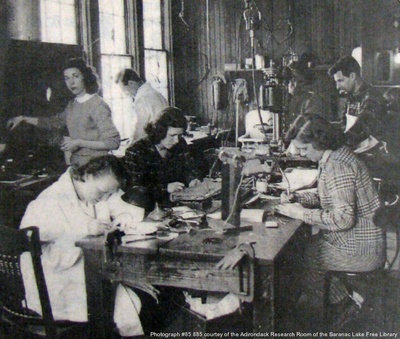 Occupational therapy such as this at the Trudeau Sanatorium led to the creation of the Study and Craft Guild
Occupational therapy such as this at the Trudeau Sanatorium led to the creation of the Study and Craft Guild  Saranac Lake Study & Craft Guild Teaching Appointment
Saranac Lake Study & Craft Guild Teaching Appointment 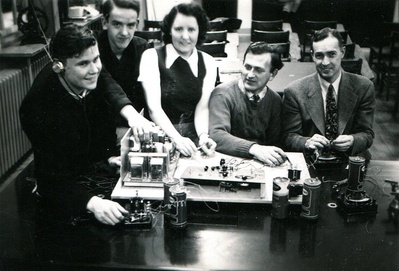 Unidentified students at an electronics class, apparently building a radio. Courtesy of Janet Dudones. The Saranac Lake Study and Craft Guild began in 1936, with the intent of providing education, job training and enrichment for the many patients who came to Saranac Lake hoping to recover from tuberculosis. Three individuals provided strong leadership to nurture the Guild: Jeanne Duplaix, William Stearns and Morris Croll. The Guild received early financial support from a Carnegie Grant as well as funding from the New York State Education Department in later years. In addition, the Guild was generously supported by celebrities and the local community. Opera star Grace Moore performed a benefit concert at the Pontiac Theater to raise funds for the construction of a new Guild House on Main Street. Like many celebrities that came to Saranac Lake, she had a personal connection to the curing community: her husband, Valentin Parera, spent time recuperating from TB in the lakeside village.
Unidentified students at an electronics class, apparently building a radio. Courtesy of Janet Dudones. The Saranac Lake Study and Craft Guild began in 1936, with the intent of providing education, job training and enrichment for the many patients who came to Saranac Lake hoping to recover from tuberculosis. Three individuals provided strong leadership to nurture the Guild: Jeanne Duplaix, William Stearns and Morris Croll. The Guild received early financial support from a Carnegie Grant as well as funding from the New York State Education Department in later years. In addition, the Guild was generously supported by celebrities and the local community. Opera star Grace Moore performed a benefit concert at the Pontiac Theater to raise funds for the construction of a new Guild House on Main Street. Like many celebrities that came to Saranac Lake, she had a personal connection to the curing community: her husband, Valentin Parera, spent time recuperating from TB in the lakeside village.
Courses offered by the Guild were diverse, covering the usual academic subjects such as Literature and History as well as the more skilled work of glove making and x-ray technique. In time, courses were opened to the local community. By 1941 its membership had reached 449, a significant upswing from its initial membership of 169. Guild membership was accessible to everyone; lifelong memberships could be purchased for $500 while "active" memberships cost only a $1. Memberships and fees contributed to the 1941 $17,000 budget with the State contributing the larger portion, $13,500. In 1947, enrollment in the guild soared to 3,646, a gain of 1,651 from the previous year.1 In 1951, the budget would grow to over $100,000.
The x-ray program successfully continued with a year-long course of study, with room and board provided at Prescott House, with fees of $400 and a $20 weekly, respectively. With the advent of effective antibiotics, the curing industry diminished as did enrollment in the Guild. In 1962, after the property was given to the Saranac Lake Free Library, the Guild House (Image) on Main Street was demolished to make room for an addition to the Library. The x-ray program later became a popular program at North Country Community College.
Source
- Bailey, Cecily. “Cure patients found purpose while learning at Guild House.” Press Republican. Plattsburgh, NY. September 12, 1983.
A timeline titled "Recreational Therapy -- 1880s to 1939," compiled by Jeffrey A. Mansfield, credits Dr. Sidney Blanchet with founding the Study and Craft Guild in 1936. He died not long afterward.
According to an article by Jim Loeb, Adirondack Daily Enterprise, January 31, 1967, the Study and Craft Guild was later renamed the Rehabilitation Guild. For the complete article, see the page on Dr. John N. Hayes. See also Saranac Lake Rehabilitation Guild.
Lake Placid News, April 24, 1942
Saranac Lake Patients To Build Model Planes
Patients in Saranac Lake who want a share in the war effort have found an answer in the Study and Craft guild’s contemplated course in model plane building.
The project consists of building models of various types of fighting aircraft for army and navy pilot schools, and is believed to be the only such class for adults in the state. The program was designed primarily fur high school students. Adults may work on models at the school, or if patients, may work at their cottage.
More than 40 patients at Trudeau alone have signified their desire to build planes. Models include the chief types of fighting planes used by the United States, Great Britain, Germany and Japan and will be used in army and navy schools in aircraft recognition training and gunnery sighting practice. They will also be used in the training of civilian airplane spotters.
The Guild News, Vol. X, No. 3, March 30, 1945 (Containing the Photoflouorographic Supplement)
Norwegians Inspect Guild Work With Disabled Merchant Sailors
Guild House was visited on March 5 by a distinguished group of officials representing the Social Welfare Committee for Norwegian Seamen in America, agency of the Royal Norwegian Government.
John Pedersen, business agent of the Committee and member of the Guild board of directors, accompanied the delegation which was headed by Fredrik Haslund, executive secretary. Also in the party were Per Thorshaug, director of the Norwegian Disability Service, and Harry Nilsson under whose supervision are the many Norwegian seamen convalescing in the Saranac Lake area.
The officials inspected the classes and workshops of the Guild and expressed satisfaction with the work being done by their men under Guild teachers.
During the winter term thirty-two seamen were enrolled in Guild classes, with twenty-nine studying English, four weaving, three algebra, two mechanical drafting, and one each in arithmetic, bookkeeping, electricity, radio theory, Spanish and typewriting.
On March 3, through arrangements made by the Guild with WNBZ. Mr. Haslund broadcast an address in English and in Norwegian to the seamen billeted here and paid high tribute to the work of the Norwegian merchant marine in the war. He thanked the community and the Guild in particular for the help given patients sent to Saranac Lake by his committee.
Adirondack Daily Enterprise, December 28, 1948
Guild's Fall Term Of Classes Shows Patient Increase
Increased rehabilitation service to the patients and ex-patients of Saranac Lake is revealed in the preliminary summary of the fall term of classes at the Saranac Lake Study and Craft Guild released today. The term closed on December 18.
Two hundred twenty-five convalescents were numbered among Guild students, an increase of twenty-three over last year. This compares with a total of one hundred thirty-three well persons registered, an increase of eighteen. The over-all enrollment of three hundred fifty-eight is 41 over the fan term in 1947.
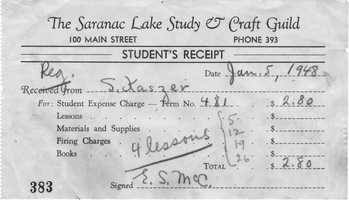 Saranac Lake Study & Craft Guild Student Receipt
Saranac Lake Study & Craft Guild Student Receipt
The most notable growth occurred in the department of arts and crafts, under the supervision of E. Blanchard Brown. Total registration numbered two hundred sixty-three.
Among the most popular courses were dress-making and alteration, with seventy-seven, drawing and painting with forty, metalwork with thirty-nine, music appreciation with twenty-nine, leatherwork with twenty-six and pottery with fifteen.
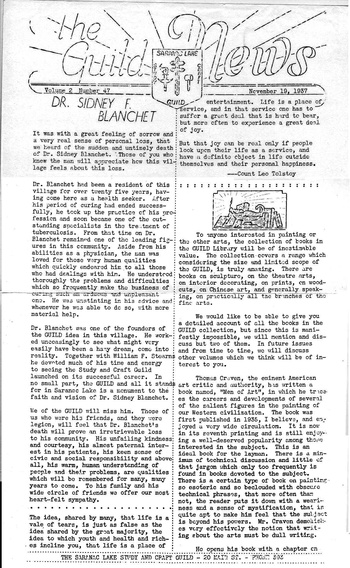 The Guild News, November 19, 1937 Dr. Sidney F. Blanchet It was with a great feeling of sorrow and a very real sense of personal loss that we heard of the sudden and untimely death of Dr. Sidney Blanchet. Those of you who knew the man will appreciate how this village feels about this loss. Dr. Blanchet had been a resident of this village for over twenty-five years, having come here as a health seeker. After his period of curing had ended successfully, he took up the practice of his profession and soon became one of the outstanding specialists in the treatment of tuberculosis. From that time on, Dr. Blanchet remained one of the leading figures in this community. Aside from his abilities as a physician, the man was loved for those very human qualities which quickly endeared him to all those who had dealings with him. He understood thoroughly the problems and difficulties which so frequently make the business of curing such an arduous and unpleasant one. He was unstinting in his advice and whenever he was able to do so, with more material help. Dr. Blanchet was one of the founders of the GUILD idea in this village. He worked unceasingly to see what might very easily have been a hazy dream, come into reality. Together with William F. Stearnes he devoted much of his time and energy to seeing the Study and Craft Guild launched on its successful career. In no small part, the GUILD and all it stands for in Saranac Lake is a monument to the faith and vision of Dr. Sidney Blanchet. We of the GUILD will miss him. Those of us who were his friends, and they were legion, will feel that Dr. Blanchet’s death will prove an irretrievable loss to this community. His unfailing kindness and courtesy, his almost paternal interest in his patients, his keen sense of civic and social responsibility and above all, his warm, human understanding of people and their problems, are qualities which will be remembered for many, many years to come. To his family and his wide circle of friends we offer our most heart-felt sympathy.
The Guild News, November 19, 1937 Dr. Sidney F. Blanchet It was with a great feeling of sorrow and a very real sense of personal loss that we heard of the sudden and untimely death of Dr. Sidney Blanchet. Those of you who knew the man will appreciate how this village feels about this loss. Dr. Blanchet had been a resident of this village for over twenty-five years, having come here as a health seeker. After his period of curing had ended successfully, he took up the practice of his profession and soon became one of the outstanding specialists in the treatment of tuberculosis. From that time on, Dr. Blanchet remained one of the leading figures in this community. Aside from his abilities as a physician, the man was loved for those very human qualities which quickly endeared him to all those who had dealings with him. He understood thoroughly the problems and difficulties which so frequently make the business of curing such an arduous and unpleasant one. He was unstinting in his advice and whenever he was able to do so, with more material help. Dr. Blanchet was one of the founders of the GUILD idea in this village. He worked unceasingly to see what might very easily have been a hazy dream, come into reality. Together with William F. Stearnes he devoted much of his time and energy to seeing the Study and Craft Guild launched on its successful career. In no small part, the GUILD and all it stands for in Saranac Lake is a monument to the faith and vision of Dr. Sidney Blanchet. We of the GUILD will miss him. Those of us who were his friends, and they were legion, will feel that Dr. Blanchet’s death will prove an irretrievable loss to this community. His unfailing kindness and courtesy, his almost paternal interest in his patients, his keen sense of civic and social responsibility and above all, his warm, human understanding of people and their problems, are qualities which will be remembered for many, many years to come. To his family and his wide circle of friends we offer our most heart-felt sympathy. 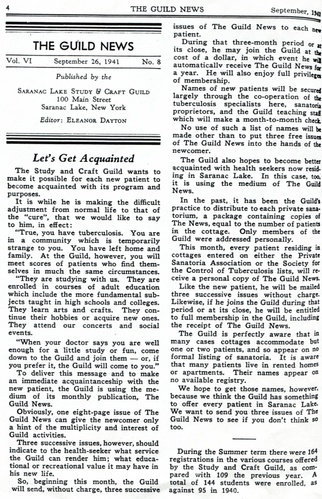 The Guild News started c. 1935 The academic department showed an increase from seventy-six to one hundred during the fall term. Fifty were in English, thirty-one in Spanish, eleven in French and seven in German.
The Guild News started c. 1935 The academic department showed an increase from seventy-six to one hundred during the fall term. Fifty were in English, thirty-one in Spanish, eleven in French and seven in German.
In commercial subjects, the registration grew from fifty-five to seventy-four, with thirty-eight in typewriting, twenty-six in shorthand and eight in bookkeeping.
Due to a drop in enrollments in the photofluorographic [x-ray] operators training course, traceable to decreased appropriations for training costs in many states, the technical department fell behind last year with fifty-nine registrations compared with ninety.
The total registration of four hundred ninety-six in all departments included three hundred forty-five in classes at Guild House, Trudeau, Ray Brook, the Hotel Alpine painting studio and the Algonquin Woodcrafters Shop. One hundred fifty-one were for side instruction in local and neighboring sanatoria.
A staff of twenty- five teachers offered a curriculum of forty-seven different subjects.
The reorganization of the counseling department, under Mrs. Tirzah W. Anderson, at the start of the fall term is believed to have stimulated the enrollment of patients in Guild classes. The department has interviewed, visited and tested a large number of applicants for rehabilitation counseling in the term and has developed educational plans for a wide variety of individual needs.
The reader's advisor, Mary D. Hoey, a regular member of the Guild staff, visited and prepared reading lists from the Saranac Lake Free Library for more than 40 bed patients in the term.
As a result of increased activity, the Guild teaching payroll, which is met partially through state and federal appropriations, received through the Franklin County Vocational Education and Extension Board, showed an increase from $15,366.25 to $19,887.00 for the period from July 1 to November 30 inclusive.
Total student hours of instruction totalled 15,746 .as compared with 13,640 last year for the same period.
The winter term of Guild classes beginning January 5, 1949, will continue most of the educational offerings of the fall term. Expansion becomes increasingly difficult, according to Guild officials, because of limitations in space and equipment.
Adirondack Daily Enterprise, October 21, 1948
GUILD FIESTA TO TAKE PLACE ON SATURDAY
The eighth annual Harvest Hop of the Saranac Lake Study and Craft Guild with its theme this year of a Latin-American "Fiesta" will lake place Saturday night in the ballroom of Hotel Saranac.
The affair will start at 9 o'-clock and continue until 1 a.m. Highlights of the fiesta will be the music of Raul Barragan and his orchestra and the singing and entertainment of Miss Rosita Rios.
Prizes will be awarded for costumes and six door prizes will be given away. Numerous other awards will be made during the evening including those for dance contests and a grand prize.
Col. Mario R. Vargas, chief of the Venezuelan Armed Forces, will be honorary chairman. Alfredo Gonzalez is chairman and is assisted by Mrs. H. W. Lockwood, Mrs. P. J. Serralles, Mrs. Walter E. Taylor and Benito Collada.
Tomorrow afternoon at 3:30 o'clock in Hotel Saranac conga lessons will be given by Mr. Gonzalez to any persons wishing to learn the steps.
All funds raised by the hop will be used for the benefit of the Guild.
Adirondack Daily Enterprise, January 12, 1951, reprinted in the Centennial edition of August 1994
Guild Offers Training In New Fields
The function of our health services is to get the patient back on his feet. The Saranac Lake Study and Craft Guild offers him a path to follow thereafter.
Founded by a group of ex-patients in 1935, still directed largely by ex-patients, the Guild is nationally known for its work in rehabilitation. It offers training at the bedside, in classes, and in laboratories to patients, ex-patients, and to any adults who feel the need for extra training in any of sixty different subjects. It is supported by the State, by contributions, and by student fees; if the student cannot pay the modest fees his training is free.
In any program to increase the use of health services in Saranac Lake, the Guild may turn out to be the most important factor of all. Because work at the Guild; can be used by sick patients to accredit themselves for college and advanced education, the Guild can be a powerful magnet for attracting younger people here. No other cure center in America offers the educational facilities which the Guild offers.
 X-ray trainees observe demonstration by Michael Garen, R.T., instructor and Guild graduate. E. H. Worthington, Jr., supervisor of technical courses., stands second from right. The group includes students from eight states and one foreign country. Guild News, June 1953. Courtesy of the Adirondack Research Room, Saranac Lake Free Library
X-ray trainees observe demonstration by Michael Garen, R.T., instructor and Guild graduate. E. H. Worthington, Jr., supervisor of technical courses., stands second from right. The group includes students from eight states and one foreign country. Guild News, June 1953. Courtesy of the Adirondack Research Room, Saranac Lake Free Library 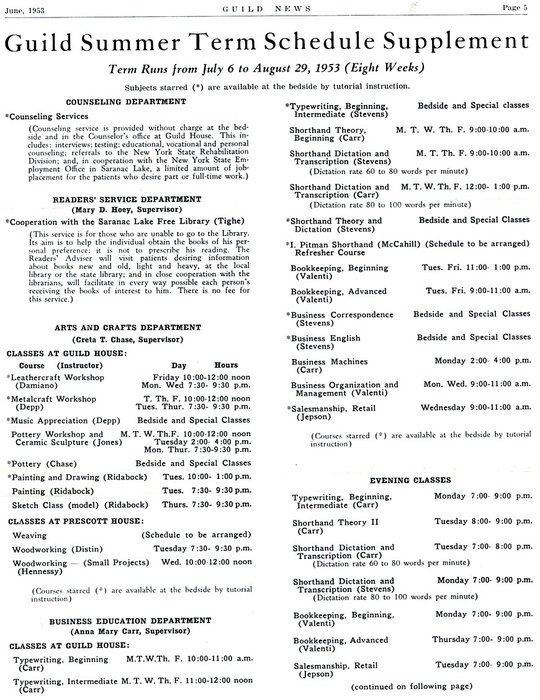 Summer Schedule, Guild News, June 1953. Courtesy of Janet Dudones.
Summer Schedule, Guild News, June 1953. Courtesy of Janet Dudones.  Summer Schedule, Guild News, June 1953. Courtesy of Janet Dudones. Adirondack Daily Enterprise
Summer Schedule, Guild News, June 1953. Courtesy of Janet Dudones. Adirondack Daily Enterprise
You Know What?
By Howard Riley
The Saranac Lake Study and Craft Guild was a venerable institution here in the 1930s 40s and into the early 50s. The name seems to have been copied from the Craft Guilds in Europe which were popular in the early 12th Century when apprentices were assigned or bound to artisans in various trades. A 1950 report to the Board of Governors reveals the role of Prescott House located (then and now) at the end of Franklin Avenue said "We expect that Prescott House, so sorely needed for the accommodation of our growing educational and rehabilitation work, will add some $6,000 to our operating costs... along with the generosity of Miss Prescott who contributed $3,200 of the Prescott House assets to the Guild."
The Guild House, as it was called, was located across from the Hotel Saranac at 100 Main Street in that little park that looks too small for that beautiful old house that held all the Guild activities. The Guild was incorporated on Feb. 14,1936 and is described in its monthly publication The Guild News as "The Guild is a part-time vocational school of Arts and Crafts administered by the Franklin County Vocational Education and Extension Board receiving funds exclusively for teaching salaries from New York State and federal sources."
One of the important courses taught by the Guild were the X-ray classes (technically the Photofluorographic Operators Training Course) where the graduates were assigned to field training around the country by the US. Public Health Service in Washington, D.C.
But Guild taught everything, it seems, from a Radio Operators Training Course leading to an FCC operator's license to Atomic Fission discussion groups explaining "electrical theory underlying the splitting of the atom. This technical list of classes which also included engineering mathematics was under the supervision of Edward H. Worthington, Jr.
There were classes on the study of Adirondack wildlife which included trees, flowers and birds along with field trips, painting, design and drawing were also scheduled courses under the supervision of Edwin Blanchard Brown titled "Arts and Crafts and a Junior Arts and Crafts School." There were various courses in dictation, typing, business English and medical stenography under the supervision of Athleen B. Lawton.
Those courses disappeared with the computer but it would not be a bad idea for someone to start teaching business English again or some kind of speaking so when you say "thank you" to someone that person could reply with "you're welcome" rather than "no problem." But "that is a story we can get to at some other time.
The opportunities presented by the Guild were for the tuberculosis patients here but others could take part in the classes if there was space. One report states, "We hope we may have the wide-spread support of the village and all who regard the pioneering work of the Guild as a means of reducing the personal and social costs of disease and disability."
In 1948 a class in radio broadcasting was offered by the Guild at the studios of WNBZ then located in the Berkeley Hotel. (WNBZ was owned by John F. Grimes who died in November 1948 at age 46, the estate then owned and operated the station until it was purchased by Jacques and Jeanne DeMattos in 1950). The course was to run for eight weeks, two hours a week, and the students would be coached and take part in the actual broadcast of a radio sketch. They would also be taught the classification and placement of microphones, pitch, line amplifiers, broadcasting signals and how to fade in and out. The course cost $2.50 a week but scholarship aid was available. In this day and age that low cost seems hard to believe. [...]
Guild News, June 1953
Short X-Ray Course Ends; Year's Course Under Way
The fifty-fifth class in the Guild's Photofluorographic Operators training course, which entered the Guild on May 6th, 1953, and which graduated on June 16th, consisted of Armand Chapdelaine of Woonsocket, R.I., John Hershock of Freeland, Penna., and Gerald E. Knapp of Cleveland, Ohio.
Following their graduation, they were assigned for six more weeks of field training under the direction of the U.S. Public Health Service, who co sponsors the course with the Guild. John Hershock's assignment is to the National X-Ray Services at Orange, New Jersey; Gerald Knapp will return to the Ohio State Department of Health, at Columbus, O., and Armand Chapdelaine goes to the city of Boston.
The Photofluorographic Operators Training course runs for six weeks — 173 hours. The 56th Class will enter the Guild September 8, 1953.
Eight members comprise General X-Ray Class No. 4, which entered the Guild on May 6th, 1953. The course lasts for approximately one year or 1786 hours. Of this, 13 weeks (325 hours) are classroom and laboratory instruction; approximately 35 weeks (1416 hours) are clinical periods at cooperating hospitals. This includes 38 hours of classroom instruction. The students return to the Guild one Saturday each month for class instruction, review, lectures and preparation for American Registry examinations.
The members of the 4th class are Paul Ashline of Saranac Lake, New York; James Butler of Washington, D. C.; Donnola Lewis of Brooklyn, N.Y.; Ljubica Gotta of Frankfort, Germany; Robert Holland of Rehoboth Beach, Delaware; Antoinette Lilla of Seneca Falls, N.Y.; Robert Sullivan of Potsdam. N.Y.; and Michael Zirpolo of Troy, N.Y.
Guild News, June 1953
SUMMER TERM PLANS
Full Schedule Offered By Teaching Staff'
The Summer Term of the Guild educational program which opens on Monday, July 6, presents a wide variety of attractive offerings in Guild House and Prescott House classes and at the bedside. The session will run for eight weeks, ending on August 29.
Three additions to the faculty are noted in the schedule which appears on pages 5 and 6 of this issue. Alfred B. Jepson, who has been sales manager for Sears, Roebuck & Co. in Buffalo for a number of years, will offer courses in Retail Salesmanship. Raymond Valenti, of the faculty of Paul Smiths College, will conduct bookkeeping and business management. Clyde Jones, from the Binghamton Public Schools, returns to the pottery shop as guest instructor.
Registrations are now being accepted for the Summer Term.
Guild News, June 1953
Business Ed. Demonstration Attracts Enthusiastic Crowd
The Business Education Department was host to approximately 200 guests during its open house held on May 25, in Guild House.
The public was given the opportunity of observing the latest models of various business machines in operation, with both Guild students and machine sales personnel acting as demonstrators. The guests manifested great interest in the adding machines, duplicating machines, calculators and posting machines. Pro- bably the greatest drawing cards were the Guild owned Royal electric type writer and a new duplicating machine, capably demonstrated by Mary Ellen Gladd and Sheila Longtemps respectively.
Local business machine and office supply agents were on hand to demonstrate products, and answer the many questions of the guests.
Demonstration classes in bookkeeping, accounting and typewriting made it clear to visitors that competent instruction is always available in Guild classes.
On display in the Pine Room were posters, text books, reference material. student projects and an impressive array of awards received by students of the Guild's Business Department.
Creta Chase, supervisor of the Arts and Crafts Department officiated at the punch bowl, and refreshments were served with the assistance of the Business Education and Pottery students.
Every student in the Business Education Department contributed in one way or another to make this evening the huge success that it was. It is evident that their efforts were appreciated by the large number of guests who attended the exhibits.
In charge of the program was Mrs. Anna Mary Carr, supervisor of the Business Education Department.
Adirondack Daily Enterprise, December 29, 1961
Former Saranac Lake Guild House Dismantled After 80 Years' Service
Main Street Site Will Be Completely Vacated by Spring To Make Way for Planned Addition to Library
A Saranac Lake landmark and one of the oldest buildings in the village will soon disappear from its site opposite the Hotel Saranac. Yesterday wreckers went to work on the former Guild House at 100 Main Street, under contract to dismantle the 80-year-old structure by June 15.
The property, which has been vacant since September 1955 when the Saranac Lake Rehabilitation Guild moved its operations to Prescott House on Franklin Avenue, was sold about two years ago by the Guild to the Saranac Lake Free Library Expansion Committee which had been formed for the express purpose of acquiring the property and preparing plans for an addition upon it for the Saranac Free Library, which it adjoins. The committee raised $6,000 by popular subscription and then deeded the land to the library.
Present plans call for possibly using the cleared plot for a parking area pending completion of plans for the library addition. Preliminary drawings have been prepared by Saranac Lake architect, William H. Scopes. The project will cost about $75,000 which will be raised by popular subscription.
The Guild House will disappear from the scene shortly, but undoubtedly, its memory will linger. On in the minds of many for quite a few years, for it has had an interesting career. It was built about 1880, apparently by Charles Manning who operated the Manning farm in conjunction with his son-in-law, Julius Morehouse. Around the turn of the century, Kenneth Goldthwaite, first publisher of the Adirondack Daily Enterprise, took over occupancy of the property. The next tenant, at least as far as can be learned, was a Dr. Fred S. Dekker, a general practitioner who lived in the house during the "teens." In 1926 the Saranac Lake Elks Lodge 1508 took over the building and used it as a clubhouse into the middle '30's. One report has Dr. Lawrason Brown an owner of the building in the '30's prior to its sale to Ignatius Newbauer, who later sold it to the Guild.
Meanwhile the Saranac Lake Study and Craft Guild had been organized in 1937, a group devoted to aiding handicapped individuals in the rehabilitation phase of convalescence. So successful was this organization in forwarding its aims and purposes that by 1910, it was obvious it was worthy of a home of its own. Through the efforts of such men as William Morris and Dr. F. B. Trudeau, Sr., funds were raised for the purchase of the building at 100 Main Street for the Guild, a project helped considerably by a free concert given at the Pontiac Theatre by the late famed opera singer Grace Moore. In 1941, the property was turned over to the Guild with great ceremony, an affair attended by Miss Moore who dedicated the property. The Guild, later changing its name to the Saranac Lake Rehabilitation Guild, operated the Guild House as an art and educational center until September 1955, and the House was a popular site for many patients in recovery from illness as they took up the study of ceramics, painting, typing and shorthand and other courses to prepare themselves for the working world. With the gift to the Guild of Prescott House, however, the usefulness of Guild House had passed and it shut down in September 1955, never to reopen. Several years ago a group of men interested in the future of the library and its expansion, saw the need for purchasing the Guild property to insure an expansion area for the library addition. With this in mind, the Expansion Commitee was formed, and the needed funds raised and the property purchased. Recently a meeting of the committee moved to suggest to the library board that the building be demolished, and the committee agreed at that time to obtain funds for the project by soliciting for it.
This the committee found unnecessary, however, through the generosity of Edmond A. Guggenheim, of Saranac Lake and New York City, philanthropist, who gave the necessary funds for both dismantling the building and leveling the land. He also gave additional funds for the new wing.
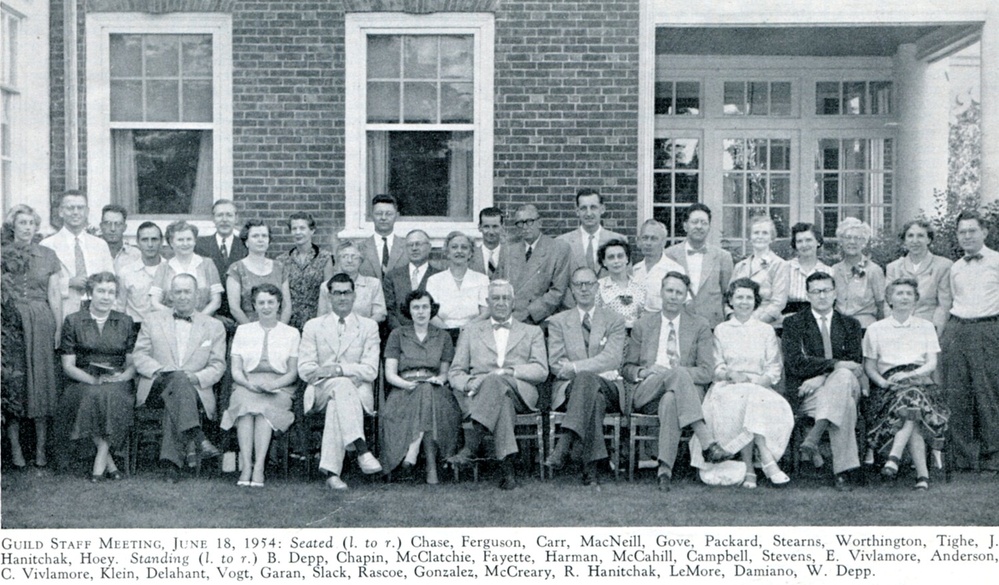 Saranac Lake Study & Craft Guild Staff. Guild News, June 1954, Courtesy of Janet Dudones.
Saranac Lake Study & Craft Guild Staff. Guild News, June 1954, Courtesy of Janet Dudones.
Saranac Lake Study and Craft Guild Staff Meeting, June 18, 1954 - Identification of photo #2008.8.19 (or 2008.8.69) at the Adirondack Research Room of the Saranac Lake Free Library.
The identifications below are compiled from three lists: a photo in the Guild News in which only last names and occasional first initials are given, and two handwritten lists by contemporary informants. The more complete list is probably by Janet Decker. The shorter list is written in two different hands.
Photo identification:
Left to right, standing:
1. Barbara Lewis Depp 2. D. Mott Chapin 3. Wayne McClatchie 4. (no first name) Fayette 5. Dorothy Harmon (Harman) 6. James McHale McCahill 7. Evelyn Campbell 8. Evelyn Stevens 9. E. Vivlamore (F), Prescott manager 10. (no first name) Anderson (M) 11. C. Vivlamore (M) 12. Estelle Klein - sewing project, sheltered workshop 13. Jack Delahant 14. Eddie Vogt 15. Michael Garan, X-ray instructor, Ray Brook 16. Nadia Slack 17. Bob Rascoe 18. Alfredo Gonzalez 19. Mrs. McCreary (Homer) 20. Ruth Hanitchak 21. Virginia LeMore 22. Angie Damiano 23. Wesley Depp Seated: 24. Creta Chase 25. Joe Ferguson 26. Anna Mary Carr 27. Wilfred McNeil 28. Esther Gove, typing teacher OTR 29. Dr. Ned Packard 30. Bill Stearns 31. Ed Worthington 32. (no first name) Tighe (F) 33. John Hanitchak, PhD, counselor 34. Mary Hoey
The Guild News, June 1954
Business Show Marked Success
More than 300 persons jammed Guild House on the evening of May 24 to witness the display staged by the Business Education department at its second annual “Open House.”
Displayed were modern office arrangements with up-to-date equipment in office machines and furniture. Dealers from Saranac Lake, Malone and Plattsburgh demonstrated machines that marked the latest improvements.
One room was devoted to the showing of a visual aid presentation outlining the“ Growth of a Secretary.” Guild business classes were also in session to demonstrate classroom procedures. A prominent feature noted by the guests was the use of recorded music to instill the sense of “rhythm typing" used widely by the department in its typing courses.
Included among the group of exhibits which proved of unusual interest to the visitors was a room marking a typical office during the period when people commuted to work in horse cars, filled the office pot belly stove from a coal scuttle and did night work with the aid of the oil lamp. A rolltop desk, quill pens, an old clock, calendar, spittoons and other antique furnishing were well set off with a period costumed office staff with James McCahill, of the Prescott House staff, in the role of the cigar smoking manager, Guild students, Miss Phyllis McKillip, pounding away on a vintage machine and his bookkeeper, Mrs. Ada Delany scratching away in an old ledger with a quill pen. Period oil lamps dimly aided their chores.
The show was the endeavor of many, but credit for it goes to Mrs. Anna Mary Carr, department supervisor, who planned the event.
The Guild News, June 1954
0. T. AIDES COURSE
On September 27, 1954, another course for Occupational Therapy Aides will be started at the Guild. In the six months the students will obtain 544 hours of instruction in various arts and crafts. Classes will also be scheduled in medical subjects and occupational therapy principles. Field trips will be arranged to various sanatoria in the area.
Mrs. Mitchell, from South Carolina, was the first person to request an aide course. With the assistance of the Division of Vocational Rehabilitation, she completed her course and then went home to work in a local sanatorium. The South Carolina Division of Vocational Rehabilitation also sent Miss Ernestine Ross to take this course. Our next student, Miss Mary Komorny, came from Binghamton, New York. She had held a part-time position in the Chenango Bridge Sanatorium but needed training before they would put her on a full time basis. Since she completed the Guild course, she has been holding the full time job.
One student has already been accepted for this coming class. Joseph Kaplan is a Canadian veteran who has been working in a hospital in Montreal. In order to keep this position he must complete an Occupational Therapy Aide Course.
This course is supervised by the Supervisor of Occupational Therapy, Esther A. Gove, with the assistance of the Arts and Crafts Department.
Shirley Morgan wrote "Crafting a Cure," an 8+ page, authoritative article on the Saranac Lake Study and Craft Guild, which was published in the November/December 2001 issue of Adirondack Life. Pictured are Guild teachers Nadia Slack and Wilfred MacNeill; Ed Worthington is mis-identified in another photo. Patients shown are Liesl Kahn-Wolz, a German refugee, and Paul Cremeti, a major in the British army. Jewelry work of Florence Moore is also shown.
Comments
Footnotes
1. “Here and There in Northern NY,” Press Republican. Plattsburgh, NY. August 29, 1947.



